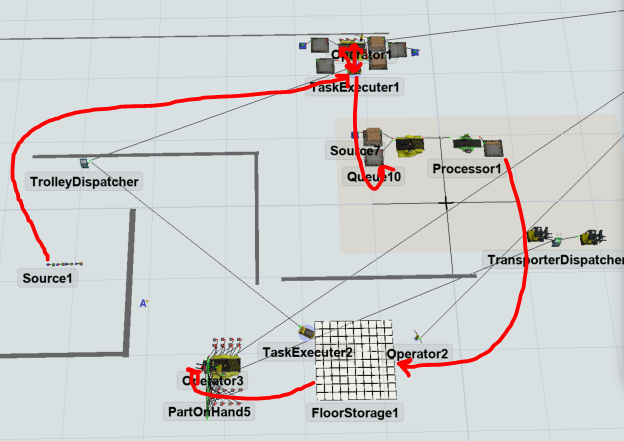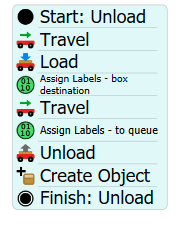Hey, all!
I'm in the process of learning how to use Statistics Collectors and Calculated Tables, and would like some advice on where I'm going wrong.
I am trying to track how far the operator travels from a collection of sources, to the queues of a combiner, to another queue of a combiner, to a floor storage space, to the queue of a Mega Combiner, as shown below.
The way that I've built the process flow for this is that after parts are unloaded to Combiner1 (the one downstream of the sources), the operator is released while a number of outputs are batched in Queue8 and the path from that Combiner to the Mega Combiner is set in a second process flow.
Due to this, I couldn't figure out which label I could use to track the operator through both process flows, so I used two Statistics Collectors, with the idea that I could combine them later as a Calculated Table. My questions are:
- Is there a Row Value I can use that will apply to both process flows?
- The object value that I assign to the token that represents 20 FlowItems is, which I hoped would create a unique label per batch to track the operator as it travelled between its different destinations, excluding the time taken to collect transporters/AGVs. The appearance of this label isn't what I expected (i.e. ".3317206837.00"). What does this mean? If I wanted to use the object label to only aggregate "Travelled Distance"s with the same Object label, how would I do this?
- Math.round(Model.dateTime)
- I've tried to implement a Calculated Table but I have only been able to aggregate the values of a column from the CombinerToMega Statistics Collector. How do I also add the "travelled Distance" value from the SourcesToCombiner Statistics Collector to that number?
- As an aside, I found this previous solution using custom code and recording to a Global Table instead of using Statistics Collector (or Calculated Tables). What are the advantages and/or disadvantages of either implementation?
My model is attached for reference multipleAggrCalcTable.fsm
Thanks in advance!








